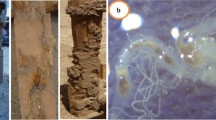Summary
The feeding behaviour of the rumen ciliatePolyplastron multivesiculatum has been studied with scanning and transmission electron microscopy. In contrast to other large entodiniomorphs,Polyplastron scarcely attaches to plant substrata such as straw or alfalfa; however, it readily phagocytes cellulose fibres (like epidermal bristles of alfalfa) suspended in the rumen fluid.
The different stages of ingestion and intracellular degradation of this particular substrate are described at the ultrastructural level.
Engulfment involves active movements of the vestibular lips. The digestion follows a peculiar pattern (“permeative” way): the cellulose substrate is gradually decomposed in situ inside the primary digestive vacuole without large fragmentation or pinching off of small vesicles. Thus degradation products are not stored in secondary vesicular systems as they are for other plant substrates (“cytotic” way).
Thus, there is no single or general pattern of cellulosic structures lysis in entodiniomorph rumen ciliates. Rather, several pathways can be observed, probably according to the nature of the ingested plant material.
Similar content being viewed by others
References
Akin DE, Amos HE (1979) Mode of attack on orchardgrass leaf blades by rumen protozoa. Appl Environ Microbiol 37: 332–338
Amos HE, Akin DE (1978) Rumen protozoal degradation of structurally intact forage tissues. Appl Environ Microbiol 36: 513–522
Bauchop T (1979) The rumen ciliateEpidinium in primary degradation of plant tissues. Appl Environ Microbiol 37: 1217–1223
—, Clark RTJ (1976) Attachment of the ciliateEpidinium Crawley to plant fragments in the sheep rumen. Appl Environ Microbiol 32: 417–422
Benyahya M (1987) Contribution à l'étude de l'ingestion et de la digestion de différents substrats cellulosiques par des microorganismes (protozoainres ciliés et bactéries) du rumen de mouton. Cytologie, cytochimie ultrastructurale. Thése 3° cycle, Université Blaise Pascal, no 889
Collombier J, Groliére CA, Sénaud J, Grain J, Thivend P (1984) Etude du rôle des protozoaires ciliés du rumen dans l'apport d'azote microbien entrant dans le duodenum du ruminant, par l'estimation directe de la quantité de ciliés sortant du rumen. Protistologica 20: 431–436
Delfosse-Debusscher J, Thines-Sempoux D, Vanbelle M, Latteur B (1979) Contribution of protozoa to the rumen cellulolytic activity. Ann Rech Vet 10: 255–257
Furness DN, Butler RD (1985) The cytology of sheep rumen ciliates. II. Ultrastructure ofEudiplodinium maggii. J Protozool 32: 205–214
Grain J, Sénaud J (1984) New data on the degradation of fresh lucern fragments by the rumen ciliateEpidinium ecaudatum: attachment, ingestion and digestion. Can J Anim Sci 64[Suppl]: 26
— — (1985) Degradation de fragments de luzerne fraiche par le cilié du rumenEpidinium ecaudatum. Attachement, ingestion et digestion. Protistologica 21: 447–466
Hungate RE (1966) The rumen and its microbes. Academic Press, New York
Jouany JP, Sénaud J (1979) Défaunation du rumen du mouton. Ann Biol Anim Biochim Biophys 19: 3 A 619–624
Nilsson JR (1979) Phagotrophy inTetrahymena. In: Levandowsky N, Hutner SH (eds) Biochemistry and physiology of protozoa, vol 2. Academic Press, New York, pp 339–379
De Puytorac P, Batisse A, Bohatier J, Corliss JO, Deroux G, Didier P, Dragesco J, Fryd-Versavel G, Grain J, Groliére CA, Hovasse R, Iftode F, Laval M, Roque M, Savoie A, Tuffrau M (1974) Propositon d'une classification du phylum ciliophora Doflein, 1901 (Réunion de Systématique, Clermont-Ferrand). CR Acad Sc Paris 278: 2799–2802
Reynolds ES (1963) The use of lead citrate at high pH as an electron opaque stain in electron microscopy. J Cell Biol 17: 208–212
Ruel K, Barnoud F, Eriksson KE (1984) Ultrastructural aspects of wood degradation bySporotrichum pulverulentum. Observations on spruce wood impregnated with glucose. Holzforschung 38: 61–68
Sénaud J, Bohatier J, Grain J (1986) Comparaisons du comportement alimentaire de deux protozoaires ciliés du rumen,Epidinium caudatum, Polyplastron multivesiculatum: mécanismes d'ingestion et de digestion. Reprod Nutr Dev 26: 287–289
— —, Benyahya M, Grain J (1986–1987) Etude ultrastructurale de l'attaque de particules de luzerne fraiche parPolyplastron multivesiculatum, cilié entodiniomorphe du rumen: ingestion et dégradation intracellulaire. Ann Sci Nat Zool 8: 61–74
Thivend P, Fonty G, Jouany JP, Durand M, Gouet P (1985) Le fermenteur rumen. Reprod Nutr Dev 25: 729–753
Vigués B, Méténier G, Sénaud J (1984) The sub-surface cytoskeleton of the ciliatePolyplastron multivesiculatum: isolation and major protein components. Eur J Cell Biol 35: 336–342
Weller RA, Pilgrim AF (1974) Passage of protozoa and volatile fatty acids from the rumen of the sheep and from a continuous in vitro fermentation system. Br J Nutr 32: 341–351
Wichterman R (1986) The biology ofParamecium. Plenum Press, New York
Author information
Authors and Affiliations
Rights and permissions
About this article
Cite this article
Bohatier, J., Sénaud, J. & Benyahya, M. In situ degradation of cellulose fibres by the entodiniomorph rumen ciliatePolyplastron multivesiculatum . Protoplasma 154, 122–131 (1990). https://doi.org/10.1007/BF01539839
Received:
Accepted:
Issue Date:
DOI: https://doi.org/10.1007/BF01539839




